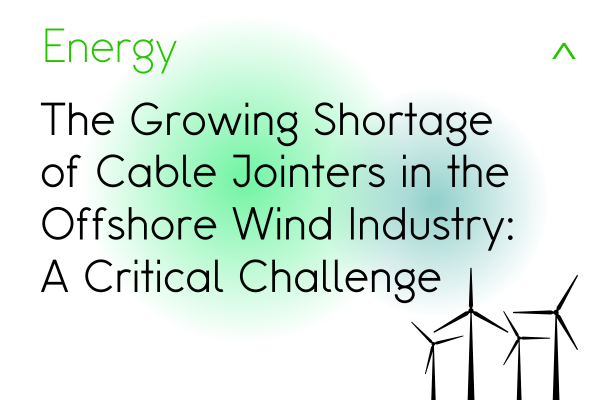
The Growing Shortage of Cable Jointers in the Offshore Wind Industry: A Critical Challenge
27 Sept, 20242minsThe Growing Shortage of Cable Jointers in the Offshore Wind Industry: A Critical ChallengeAs...

The Growing Shortage of Cable Jointers in the Offshore Wind Industry: A Critical Challenge
As the offshore wind industry continues its rapid expansion, a critical skills shortage is emerging that threatens to slow down progress: the lack of qualified cable jointers. This specialised role is becoming increasingly vital as the sector grows, yet the supply of skilled professionals is struggling to keep pace with demand. Let's delve into this pressing issue and explore its implications for the future of offshore wind.
The Role of Cable Jointers in Offshore Wind
Cable jointers play a crucial role in the offshore wind industry. These highly skilled technicians are responsible for connecting and repairing the complex network of underwater cables that transmit power from offshore wind turbines to onshore substations. Their expertise is essential for:
1. Installation: Joining cables during the initial installation of wind farms.
2. Maintenance: Repairing damaged cables to minimise downtime.
3. Upgrades: Connecting new turbines or expanding existing wind farms.
The Growing Demand
Several factors are contributing to the increasing demand for cable jointers:
1. Rapid Industry Expansion
The offshore wind sector is experiencing unprecedented growth. According to Spinergie analysis, by the end of 2023, cable laying vessels had installed 2,345km of cable across various industries, marking a record year. This volume was over 650 km more than in 2022 and almost double the amount recorded in 2017.
2. Larger and More Complex Projects
As wind farms grow larger and are situated farther offshore, the complexity and length of cable networks increase. This trend demands more skilled professionals to handle the intricate work of cable joining.
3. Ageing Infrastructure
Early offshore wind projects are beginning to require more maintenance and repairs as they age, further increasing the need for skilled cable jointers.
4. Technological Advancements
The industry is moving towards higher voltage cables and more sophisticated transmission systems, requiring cable jointers to continually update their skills and knowledge.
The Supply Challenge
Despite the growing demand, the supply of qualified cable jointers remains limited due to several factors:
1. Specialised Training Requirements
Becoming a proficient cable jointer requires extensive training and experience. The specialised nature of offshore work adds another layer of complexity to the skill set required.
2. Limited Training Programmes
There are relatively few training programmes specifically tailored for offshore cable joining, limiting the pipeline of new professionals entering the field.
3. Competition from Other Sectors
The skills of cable jointers are also in demand in other industries, such as onshore power transmission and telecommunications, creating competition for this limited talent pool.
4. Ageing Workforce
Many experienced cable jointers are approaching retirement age, exacerbating the skills shortage.
Implications for the Industry
The shortage of cable jointers has several significant implications for the offshore wind sector:
1. Project Delays: A lack of qualified professionals can lead to delays in installation and maintenance, potentially slowing down the overall growth of the industry.
2. Increased Costs: As demand outstrips supply, the cost of hiring skilled cable jointers is likely to rise, potentially impacting project budgets.
3. Reliability Concerns: With fewer experienced professionals available, there's a risk of reduced quality in cable installations and repairs, potentially affecting the reliability of offshore wind farms.
4. Innovation Bottleneck: The shortage could slow down the adoption of new cable technologies if there aren't enough skilled professionals to implement them.
Addressing the Shortage
To tackle this growing challenge, the offshore wind industry needs to take proactive steps:
1. Invest in Training: Develop and fund specialised training programmes to create a new generation of offshore cable jointers.
2. Industry Collaboration: Establish partnerships between wind farm operators, cable manufacturers, and educational institutions to create comprehensive training initiatives.
3. Technology Integration: Explore ways to use technology, such as augmented reality, to assist less experienced technicians and potentially reduce the skill level required for some tasks.
4. Attractive Career Paths: Promote cable joining as an exciting and rewarding career option in the renewable energy sector to attract more young professionals.
5. Knowledge Transfer: Implement mentoring programmes to ensure that the expertise of experienced cable jointers is passed on to newcomers in the field.
Conclusion
The shortage of cable jointers represents a significant challenge for the offshore wind industry, but it also presents an opportunity. By addressing this skills gap proactively, the sector can not only overcome a potential bottleneck in its growth but also create valuable, skilled jobs as part of the transition to renewable energy.
As the industry continues to expand and evolve, the role of cable jointers will remain crucial. Ensuring a steady supply of these skilled professionals will be key to meeting ambitious offshore wind targets and supporting the global shift towards sustainable energy sources. The time to act is now, to build the workforce that will connect our renewable energy future.

